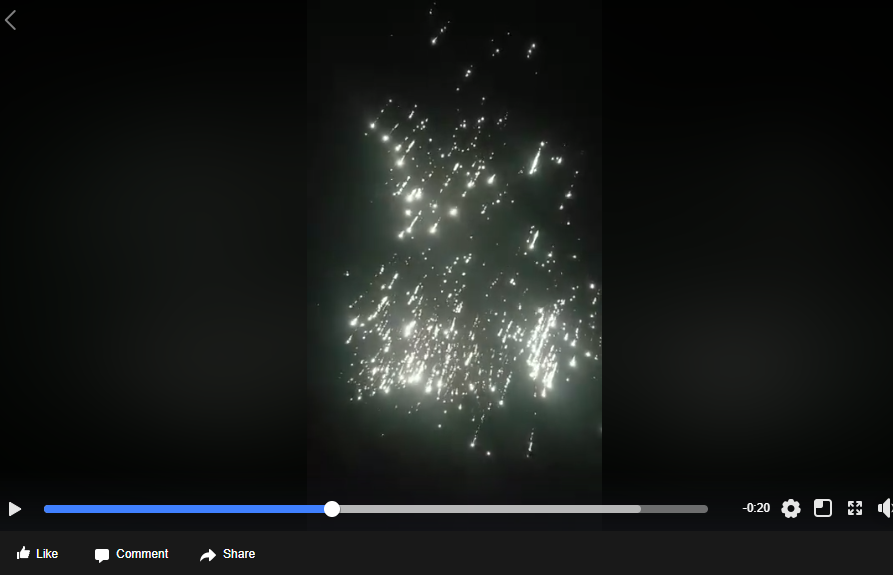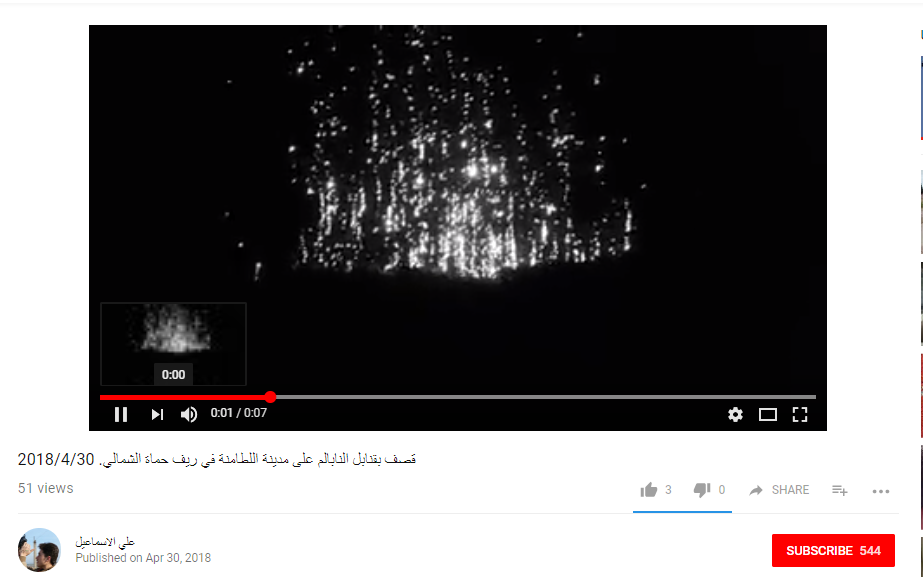Introduction: During April 2018, cities and towns of the northern countryside of Hama witnessed a violent military escalation by Syrian regular forces and their allies; they were bombarded with several types of weapons, including incendiary substances. On April 26, 2018, Kafr Zita city[1] was shelled with several artillery shells loaded with incendiary substances similar to phosphorous, causing significant material damage to civilians' property. Kafr Zita had been already bombarded with incendiary substances three times in April 2018.
Shelling of the Syrian regular forces was not limited only to Kafr Zita, as the city of al-Lataminah[2] was also attacked with incendiary substances similar to phosphorous. April 30, 2018, the city's farms and residential areas were attacked by several artillery shells loaded with incendiary substances, causing fires to break out in houses of many civilians. Al-Lataminah was shelled several times during April 2018.
These attacks came in the framework of the military campaign that have been launched since October 2017 by the Syrian regular forces and their allies in an attempt to control several villages and towns in Hama and Idlib countryside. According to the field researcher of (STJ), one of the reasons of this recent military escalation on the northern countryside of Hama is due to the advance made by military opposition factions, notably the Izza Army in Hama countryside; the factions could control both towns of Krnaz and al-Hamamiyat on March 14, 2018. Following this progress, the regular forces severely shelled the areas of northern Hama in order to practice pressure on the popular incubator as well as the opposing factions to withdraw from those areas, the field researcher indicated.
First: Shelling Kafr Zita with Incendiary Substances Four Times during April
During April 2018, Kafr Zita was attacked with incendiary substances; one of the attacks was at 4:00 pm, Apr 26, 2018, when the Syrian regular forces stationed at at-Trabee' Checkpoint, south of Halfaya, attacked the town with several artillery shells loaded with incendiary substances similar to phosphorous, causing fires in large spaces of the agricultural crops such as wheat and barley, as well as damage to civilians' property. Ahmad al-Ali, a media activist in Kafr Zita, confirmed this to STJ and said,
"The repeated shelling on Kafr Zita with incendiary substances is due to attempts by the regular forces to practice pressure on the popular incubator in the city. The locals in the northern countryside of Hama experienced a state of panic and fear after the repeated shelling by the Syrian regime and its Russian ally with rockets loaded with phosphorous and napalm during March and April 2018. On March 21, 2018, the Russian warplane launched two airstrikes loaded with incendiary phosphorous on Kafr Zita; the attacks were carried out at night despite the presence of a monitoring point affiliated to the Turkish forces near the city. The two airstrikes caused no casualties, but it should be recalled that the city is witnessing this escalation as it is the most largest military fortification of the armed opposition factions like the Izza Army, besides there are also hundreds of combatants."

Another image shows some of Kafr Zita shelling with incendiary substances similar to phosphorous on April 26, 2018. Photo credit: Shabab Latamneh Facebook page.
A video footage published by Kafr Zita Facebook page showed part of the shelling with incendiaries similar to phosphorous on April 23, 2018.

An image, taken from the previous video footage, shows part of Kafr Zita shelling with incendiaries similar to phosphorous on April 23, 2018.
Fayyad Satouf, a media activist from Kafr Zita, told STJ, that the Syrian regular forces escalated their attacks of incendiary substances on the northern areas of Hama countryside in 2018, and said in this regard:
"Since early 2018, the northern countryside of Hama was targeted with 15 airstrikes loaded with incendiary substances. The strikes distributed to 14 towns and villages and caused panic and fear among the residents and forced them to flee to safer areas such as border camps. in 2017, the northern countryside of Hama was also targeted with 165 incendiary-laden airstrikes, whereas in 2016, it was bombarded with 55 airstrikes with rockets loaded with incendiary materials. Al-Lataminah city had the largest share of the bombardment since the sum of all these years was 110 aerial attack with incendiary substances."
Second: Targeting Residential Areas within al-Lataminah with Incendiary Substances Similar to Phosphorous
Al-Lataminah as well had a proportion of shelling with incendiary substances. April 30, 2018, at 12:30 am, the Syrian regular forces stationed in Halfaya targeted the farms and residential areas in al-Lataminah city with several artillery shells loaded with incendiary substances similar to phosphorous and caused material damage to the civilians' property, but no casualties recorded. Abdunnaser al-Hoshan, who hails from al-Lataminah, confirmed this to STJ saying,
"This is not the first time that al-Lataminah is attacked by incendiary weapons; shelling with these weapons has increased since the middle of April 2018. By using such weapons, the regime deliberately burns the agricultural crops of the locals and destroys their property as a technique of pressure and coercion to make them implement demands of the regime and handover the areas. During April 2018, al-Lataminah was shelled several times with incendiary weapons and the reason of increasing the frequency of shelling in northern Hama countryside in general is the recurrence of military confrontation between the regime forces and opposition factions. Thursday, April 26, 2018, there was a fierce battle between the two sides, when the opposition factions, notably the Izza army, launched a sudden attack on positions of the regime's forces in al-Hamamiyat, near Kafr Zita, it succeeded to make significant progress and control the town within few hours, but it withdrew the next day because of the intensity of the bombardment on the town, in addition the regime forces targeted Kafr Zita and al-Lataminah with dozens of missiles and rockets loaded with incendiary substances and caused burns in the agricultural crops."
Hoshan added that al-Lataminah had been already attacked with incendiary materials in March and February 2018. On Wednesday, February 13, 2018, warplanes believed to be Russian bombed the city by several airstrikes and dropped several rockets loaded with incendiary substances similar to phosphorous. The attacks directly targeted civilian houses, killed two civilians and injured others. Whereas on March 10, 2018, the Syrian regular forces stationed in Masasnah Checkpoint, located in Zellin city south of al-Lataminah, shelled al-Lataminah with incendiary substances and caused material damage to civilians' houses.
A video footage published by activists showed some of the bombardment affected to al-Lataminah with incendiary substances similar to phosphorous on April 30, 2018.

An image taken from the previous video footage that shows some of shelling al-Lataminah with incendiary substances look like phosphorous on April 30, 2018.
In a further testimony obtained from Mohammed as-Sami, an expert of remnants of war in Hama countryside, told STJ that phosphorous bombs are classified as sub-munitions, such as cluster bombs, and are carried by various incubators and dropped by warplanes or rocket missiles or artillery. He added:
"Incendiary phosphorous substances can never be extinguished by primitive tools such as those available at the Civil Defense centers. At first, the residents of northern Hama were unfamiliar about how to deal with these substances to reduce their effects on the ground. We always warned people about the need to be inside their homes in case there were no shelters. It is a requirement that the substance is exposed to air in order to expire because the phosphorous atoms react with oxygen atoms in the air, thus speeds up the process of its expiry."
As-Sami indicated that the Syrian regular forces had been recently bombing civilians in al-Lataminah and Kafr Zita with incendiary substances composed of napalm and phosphorus together; this type is commonly called "Phosphoric Napalm". He said people should be aware of the right way to deal with these incendiary substances, since they cause burns to the human skin after being exposed to them, and they may lead to severe consequences that can reach the bones. Consequently, this may lead to amputation of the hand or foot.
[1] The Izza Army controls Kafr Zita city, and is considered to be one of the most prominent active military formations in the northern countryside of Hama; it was formed in mid-2014 and has fought several battles against the Syrian regular force. al-Lataminah city is the most important center of this army, from where the major Jamil al-Saleh, Commander-in-Chief of the Army, hails from.
[2] The Izza Army controls al-Lataminah as well.

